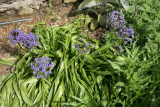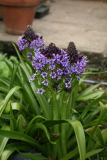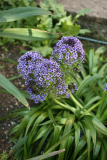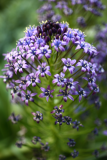Additional notes (click to expand)
Nomenclature
Previously called Hyacinthus indicus bulbosus stellatus and Hyacinthus stellatus peruanus.
Linnaeus, Carl.(1753). Species Plantarum p.309 in Ray Society facsimile of 1957
"The scientific name peruviana, "of Peru" results from confusion over the origin of the specimens from which the species was described by Carolus Linnaeus in 1753; he was given specimens imported from Spain aboard a ship named Peru, and was misled into thinking the specimens had come from that country" according to Wikipedia, May 2014. However it was called Hyacinthus peruanas, Hyacinth of Peru, with a good wood cut in Gerard (1633),p. 109, and Parkinson (1629) p.124 et seq. before Linnaeus was born, so this is not true. Parkinson calls it 'Hyacinthus stellatus Boeticus major, vulgo [commonly called] Periianus, the Great Spanish Starry Iacinth, or of Peru'. After the severe winter of 1606-7 Parkinson had plants sent to him in 1607 from Spain by Guillaume Boel, probably from Porto Santa Maria where they grow abundantly. He reports that it was given the name Eriphorus peruanus and Hyacinthus stellatus Peruanus by the first importer, to indicate that it came from Peru, either from ignorance or to hide its true origin to make it 'better esteemed'. The hyacinths/Scilla are completely omitted from Parkinson (1640). It appears as Scilla Hispanica, Hispanicae flosculi stellati and Cepa Marina in Lobel (1576) p.75 and appears to be also separately entered as 'Bulbi Eriophori genuina' (p. 58,59), with woodcuts. It does not appear in Fuchs (1542, 1551) although the Scilla illustrated there has a similar bulb and leaves, the flowers have rounded petals; nor does it appear in Ruel (1547); Dodoens (1554); Matthioli (1569); or Lyte (1578).
Oakeley, Dr. Henry F. (2014). Conium maculatum, Hemlock, Cicuta, Conio.
link
Phytochemistry
Contains cardiac glycosides
Toxicity
Sap is irritant and causes skin rashes. It contains cardiac glycosides which, if ingested, cause vomiting, abdominal pain, slow pulse and death.
Oakeley, Dr. Henry F. (2014). Conium maculatum, Hemlock, Cicuta, Conio.
link
Geographical distribution
- Africa, Macaronesia, Canary Is.
- Africa, Northern Africa, Algeria
- Africa, Northern Africa, Egypt
- Africa, Northern Africa, Morocco
- Africa, Northern Africa, Tunisia
- Europe, Southeastern Europe, Italy
- Europe, Southeastern Europe, Sicilia
- Europe, Southwestern Europe, Portugal
- Europe, Southwestern Europe, Spain
Scilla peruviana L.
Family: ASPARAGACEAEGenus: Scilla
Species: peruviana L.
Common names: Portuguese Squill
Distribution summary: Mediterranean
Habit: Bulbous
Hardiness: H4 - Hardy; average winter
Habitat: Dry grassland, scrub, meadows, open woodland, roadsides
Garden status: Not currently grown
Flowering months: April, May
Reason for growing: Toxic



